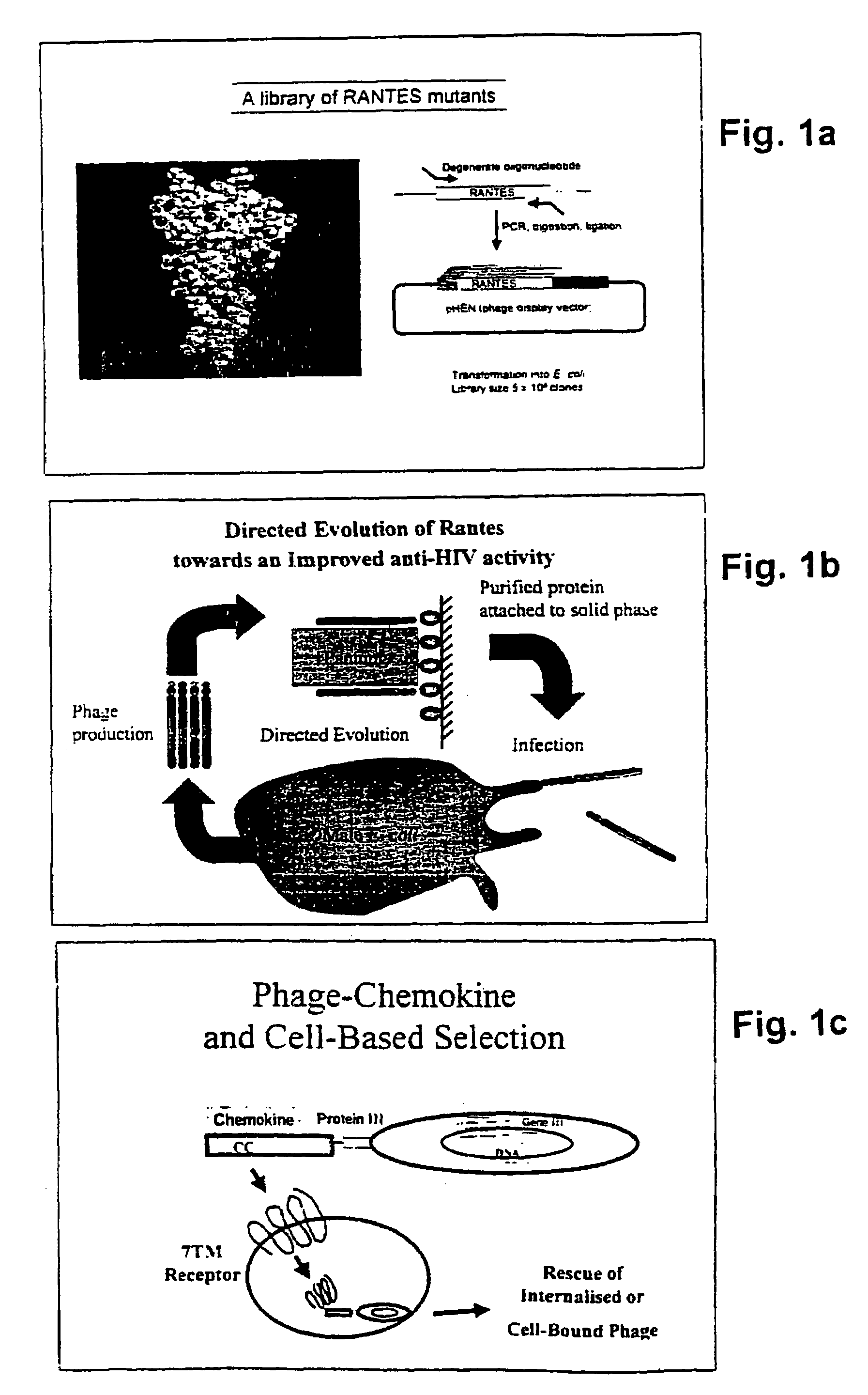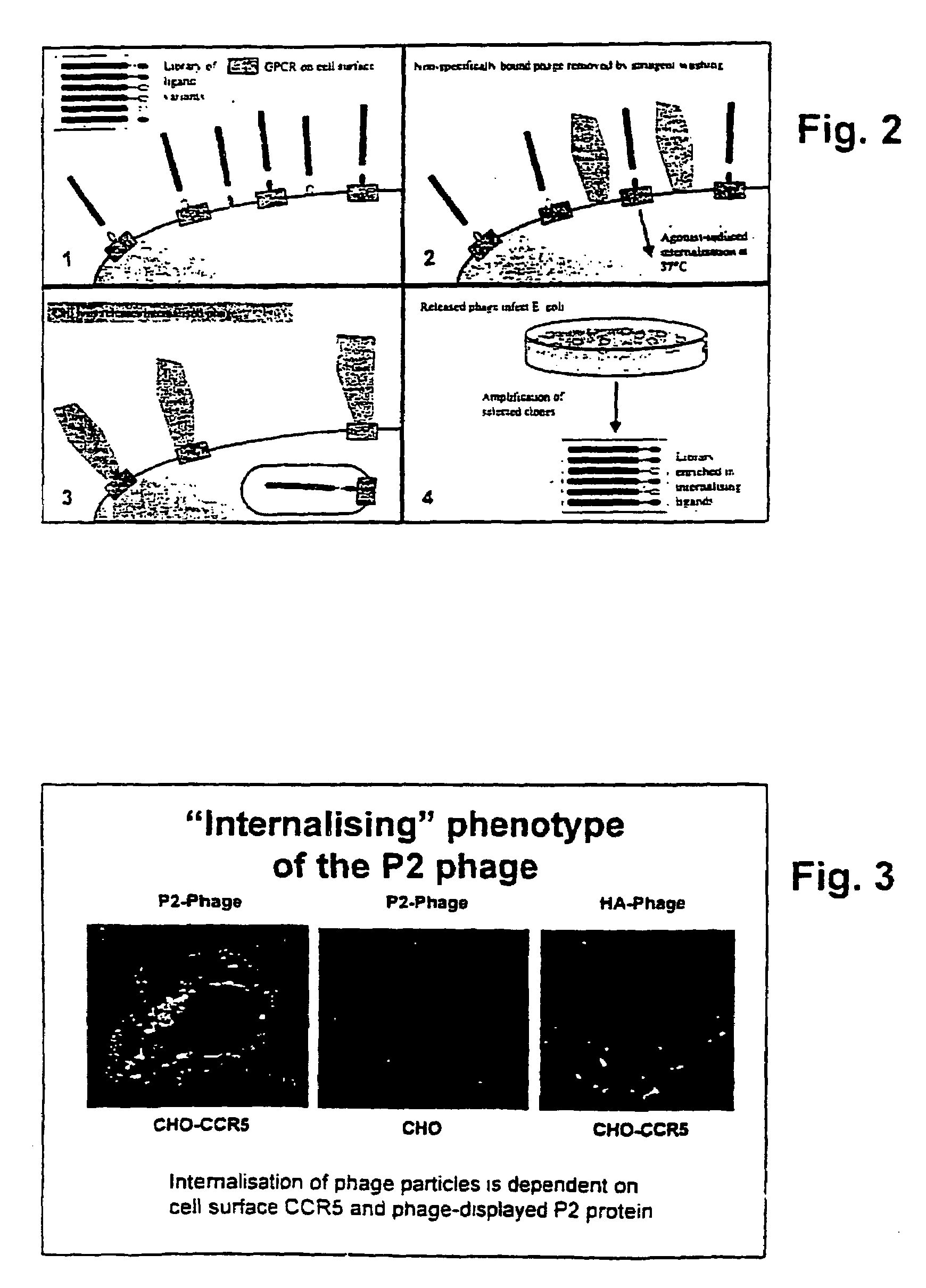Methods and construction and screening of libraries of chemokine variants
a technology of chemokine variants and libraries, applied in the direction of directed macromolecular evolution, drug compositions, peptides, etc., can solve the problems that the conventional phage display techniques are not easily applied, and achieve the effects of relatively low cost and ease, rapid evolution rate of hiv-1, and convenient us
- Summary
- Abstract
- Description
- Claims
- Application Information
AI Technical Summary
Benefits of technology
Problems solved by technology
Method used
Image
Examples
example 1
Selection of RANTES Variants by Biopanning
[0104]The interaction between chemokines and their cognate receptors is influenced by cell type-dependent variations in both the quantity and type of cellular components, for example cell surface proteoglycan (31) and intracellular proteins involved in receptor endocytosis (32). The inventors therefore chose to use two different cellular backgrounds, Human Embryonic Kidney (HEK) and Chine Hamster Ovary (CHO), for our biopanning strategy. Three independent biopanning experiments were carried out, each of which features three rounds of selection (and amplification). In two cases, a single cell background was used in each of three rounds (HEK-CCR5; CHO-CCR5), while a third strategy involved alternating the cell background between rounds (HEK-CCR5 & CHO-CCR5). Comparison of the selected sequences enabled us to define a consensus sequence, LSP#SSQSSA (SEQ ID NO: 29).
[0105]Table 1 hereunder displays the sequences of clones selected using the “biop...
example 2
Selected RANTES Mutants Show Enhanced Anti-HIV Activity
[0111]The RANTES mutants P1 and P2 were prepared by total chemical synthesis. Firstly, we compared their anti-coreceptor activity with that of RANTES in an R5-tropic envelope-mediated cell fusion assay (FIG. 4A). In this assay, both the mutant proteins had extremely potent activities (IC50 values of 7 nM (95% confidence limits: 3–15) and 0.6 nM (0.4–0.9)), which compare favourably with that of AOP-RANTES (IC50 value of 3 nM (2–6)), while RANTES did not achieve 50% inhibition at the concentrations used. RANTES, unlike AOP-RANTES, achieved only relatively inefficient protection of macrophages from R5-tropic HIV (11). With this in mind, we measured the ability of the RANTES mutants to inhibit entry into MDM in a single-tropic HIV (11). With this in mind, we measured the ability of the RANTES mutants to inhibit entry into MDM in a single-round infectivity assay using HIV-1 particles pseudotyped with the R5 HIV-1 BaL envelope. RANTES...
example 3
[0112]We sought to investigate the extent to which cell surface receptor blockade and receptor sequestration contribute to the enhanced antiviral activity of the selected RANTES mutants. Firstly, we compared their affinity for CCR5 with that of RANTES, which competes with MIP-1 a with an IC50 value of 1.7 nM (95% confidence limits: 0.8–4; see supplementary information). The selected mutants had significantly higher apparent receptor affinity, with IC50 values of 0.3 nM (0.2–0.7) and 0.2 nM (0.1–0.3) for P1 and P2, respectively. Subsequently, we measured the ability of the mutants to induce steady-state downmodulation of CCR5 from the surface of CHO-CCR5 cells. Under the experimental conditions used, neither RANTES nor P1 were capable of reducing surface receptor levels below 80% of control levels. In contrast, P2 clearly induced dose-dependent receptor downmodulation with an efficacy comparable to that of AOP-RANTES (FIG. 5). Similar results were obtained using HE...
PUM
| Property | Measurement | Unit |
|---|---|---|
| pH | aaaaa | aaaaa |
| pH | aaaaa | aaaaa |
| pH | aaaaa | aaaaa |
Abstract
Description
Claims
Application Information
 Login to View More
Login to View More - R&D
- Intellectual Property
- Life Sciences
- Materials
- Tech Scout
- Unparalleled Data Quality
- Higher Quality Content
- 60% Fewer Hallucinations
Browse by: Latest US Patents, China's latest patents, Technical Efficacy Thesaurus, Application Domain, Technology Topic, Popular Technical Reports.
© 2025 PatSnap. All rights reserved.Legal|Privacy policy|Modern Slavery Act Transparency Statement|Sitemap|About US| Contact US: help@patsnap.com



